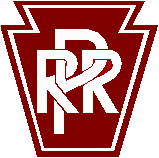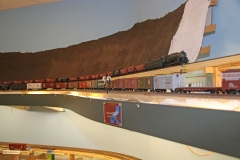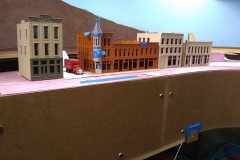 Scale
HO Scale
Status
Active
Clock Speed
4:1
Communication
Vintage Telephones
Control
NCE Wireless DCC and C/MRI
Crew Size
7 to 13
Dispatching
CTC
Era
1944
Forwarding
Cars Cards and Waybills
Layout Size
Multi-Deck, L-Shaped: 29' x 13' and 8' x 10'
Listed Jobs
CTC Dispatcher
Locale
Western Pennsylvania
Subdivision
Juniata Secondary
Superintendent
Jack Cutler
Scale
HO Scale
Status
Active
Clock Speed
4:1
Communication
Vintage Telephones
Control
NCE Wireless DCC and C/MRI
Crew Size
7 to 13
Dispatching
CTC
Era
1944
Forwarding
Cars Cards and Waybills
Layout Size
Multi-Deck, L-Shaped: 29' x 13' and 8' x 10'
Listed Jobs
CTC Dispatcher
Locale
Western Pennsylvania
Subdivision
Juniata Secondary
Superintendent
Jack Cutler
Model Railroad Theme:
A fictitious PRR CTC controlled branch line pressed into main line operation to support heavy war time traffic. The CTC design is an experimental system that the PRR was testing for applicability across their system.
Description:
The layout is a proto-freelanced, CTC controlled single-track branch line of the PRR. It represents a fictitious branch in the Allegheny Mountains that was pressed into mainline service during WWII when the Germans successfully sabotaged Horseshoe Curve.
The layout is a work in progress. All efforts so far have been in planning of the track layout, building the bench work, installing the track and its associated wiring, and installing signals and their associated control system. The layout uses Bruce Chubb’s C/MRI for the signal control system, with a virtual, prototypically correct US&S CTC panel driven by Bill Carr’s homemade software using Visual Basic. Train crews communicate with the dispatcher by a telephone system, which is complete with period-appropriate handsets. All turnouts are hand-built, either using FastTracks jigs or sratchbuilt from templates. Control is NCE wireless DCC. The scenery is minimal.
The layout room is L shaped, with the long leg being approximately 29′ x 13′ and the short leg being approximately 8′ x 10′. The layout itself is a multi-deck linear walk-around design. A 4.5 turn helix is used to transition between the two main levels.
Schematically, the mainline is single track with passing sidings at five towns, terminated at each end with an 11 track staging yard. The mainline run is approximately 360 feet, including trackage in the helix. There is a division point yard, which schematically is about half way between the staging yards.
The staging yards are open and stacked above each other on a center peninsula. The peninsula benchwork is constructed using a “quasi-mushroom” design; “mushroom” because a viewer can only see one staging yard from one-side of the peninsula; “quasi” because there is no raised floor.
Industries Modeled:
The layout includes a coal branch that goes to a coal mine and a resort. The resort, known as Concetta Springs, was opened when a new mine shaft exposed a hot springs. During WWII, some resorts were used to house German POWs, and the layout runs a POW “troop” train to simulate this.
Operations:
The layout is a fictitious PRR branch in the Allegheny Mountains (east of Pittsburgh) during WWII, specifically June 7th 1944, and operation simulates heavy war time traffic to support the allied invasion of “Fortress Europe”. It features a prototypical PRR position light signaling system using C/MRI, highlighted by a US&S CTC “virtual” panel that functions true to the prototype. The term “virtual” refers to the fact that it is a computer screen with color graphics that looks and operates like a real US&S CTC machine.
The layout is operated East-West point-to-point, terminated at each end with a staging yard. Schematically, the mainline is single track with passing sidings at five towns with staging at both ends. There is a division point yard approximately half-way between staging. Many through trains require engine servicing and a cabin car swap (to simulate a crew change) at the division point yard. There are a lot of through trains to simulate heavy war traffic, but there are two local switching turns that begin at the yard. A single-track, non-signaled coal branch leaves the mainline at a signaled junction, and continues on a third deck to a sixth town where there is a coal mine and resort. During WWII, some resorts were used to house German POWs, and the layout runs a POW “troop” train to simulate this.
The mainline is now fully signaled and is dispatched by a CTC Dispatcher. Guests are encouraged to dispatch on the virtual CTC panel. Train crews communicate with the CTC Dispatcher by a telephone system, which is complete with period-appropriate handsets. The layout can accommodate 7 to 13 guest operators, as follows:
- For a full-scope session with up to 13 guests, the CTC station is manned by two guests: one handles the telephone communications and keeps track of trains on the Train Sheet, and the other operates the virtual CTC panel. It is desired that one of the two dispatchers have previous experience dispatching on the Juniata Secondary, and the experienced dispatcher can then mentor a new dispatcher.
- For a reduced-scope session with only 7 operators, the main line traffic is greatly reduced (up to 8 trains that run in the regular schedule are annulled in the reduced schedule) and the CTC station is manned by one guest who handles all the CTC tasks alone.
Operations are conducted using car cards and waybills with a sequenced train schedule. Train control is walk-around using NCE wireless DCC handheld cabs (no tethers).
Here is a link to a YouTube video of the March 2022 session: https://www.youtube.com/watch?v=xnSl1tNRO6c
Parking Restrictions:
Yes
Location Comments:
Park on street. Entry is via the garage pedestrian door, then down a flight of stairs to the basement. Entry into the layout is via a swinging gate and nod-under. The layout is not handicap accessible.


